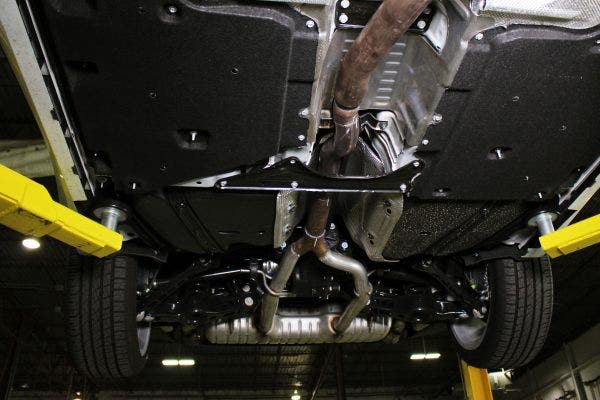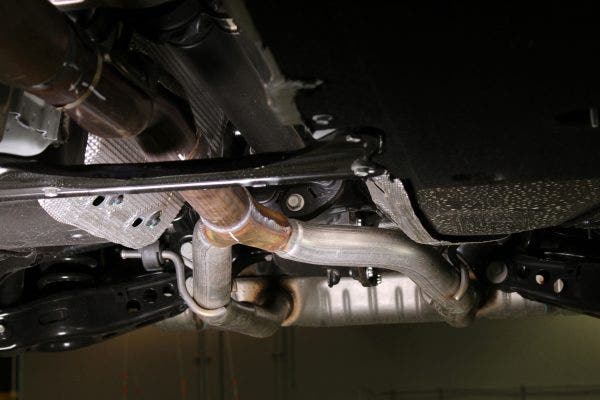
Makin' Our Camaro Purr - Catback R&D, Part 1: Stock Review
Here I stand, firmly within the land of people who spend egregious amounts of money on car parts, as I look back and wonder how in hell I got here. Those of us in my position often place the blame on a nasty little creature called the "mod bug."
The mod bug, as they say, is a tricky little bastard. Though you may think most damage-imposing biting insects live in Australia, I can assure you, this one is alive and well in the Americas. I've had firsthand experience as a victim, and it isn't pretty - just ask my bank account.
The feeling of that bug biting for the first time is unforgettable. At the beginning, you say "just an exhaust and springs, and then my car'll be perfect". Enter mod bug. Before you know it, you're dropping a Ferrari engine in your wide-body FR-S.
This mod bug, once it bites, initiates within its victim a descent into a pit of expenditures - ones that grow logarithmically in magnitude. Exhausts, intakes, springs, wheels, tires - oh my! From a public health perspective, the implications are expansive: more and more cool cars on the road, smaller and smaller bank accounts, bigger and bigger smiles on your face after the over-the-shoulder look back at your car in the parking lot at Walgreen's, and a pandemic of eye-rolls from spouses everywhere.
I remember my first catback.
What exactly is a catback, though? Well, as I briefly touched upon in our Mishimoto Camaro downpipe post, terminology for exhaust components varies by make/model-specific communities. The reason for this confusion is because it's difficult to come up with standard terms for individual segments of exhaust when every car is designed with a different layout.
Catback? Why not "Dogback"?
Our term "catback" originated as a reference to the section of the system located downstream of the last catalytic converter. Often, a catback will start towards the front-middle of the car where the test pipes or downpipes end. Such is the case on our Camaro exhaust, so we will define the catback as the section from the end of the downpipe all the way back to the exhaust tips.

A totally different animal.
On this car, the catback system is pretty straightforward. On the mid sections of some exhausts, many cars incorporate resonators, additional mufflers or cats, and other functional emissions or sound-related design features. On this Camaro exhaust, however, these additional elements would be superfluous. Given the sizeable catalytic converter located in the downpipe, this car does not need any further emissions equipment downstream.

Turbochargers, as a side-effect of harvesting kinetic energy from the exhaust, inherently muffle engine sound, bringing the volume down a bit compared to how an engine might sound without forced induction. Given the turbocharged nature of our Camaro, there is not a whole lot of volume that requires anything more than the rear-most muffler to be adequately stifled, and as many of you can surely attest, even that is overkill! This car is quiet. Too quiet.
Exploring the Anatomy of a Catback
Basically, this system is just that - basic. From the downpipe, the exhaust routes toward the rear of the car through a channel in the center of the car below the driveshaft. Upon reaching the rear of the car, the exhaust features a Y-pipe that splits the system into two separate tubes. These tubes pipe the exhaust to the muffler. Just before reaching the muffler, the exhaust encounters a crimped section of piping on each side. The Camaro SS exhaust has a similar section, but after extensive dyno testing of that car with and without the crimp, we determined that the crimp did not make a difference as far as power was concerned. Our thought is that the crimps help with serviceability and clearance.

After the exhaust has traveled through the rear-mounted "suitcase" muffler, it surges forth from dual tips in the rear of the car. Unfortunately, there's not a whole lot of volume left to hear that LTG scream. We'll be sure to address that so you'll actually be able to hear your Camaro.
So, this is a pretty simple setup, but in what ways can we improve upon it? For starters, we'll certainly be swapping out that heavy suitcase muffler with some lighter, less restrictive alternatives to bring out the sound and let the exhaust flow without imposition.
We'll be designing our system without crimps and we'll also play around with the diameter of the piping throughout the system to see what works and what doesn't. Larger pipe diameter will allow us to squeeze more power out of the system by enabling the car to breathe a bit more easily. But I don't want to give too much away right off the cat bat!
Stay tuned and learn more about our plans for this turbocharged Camaro catback in the next post.









